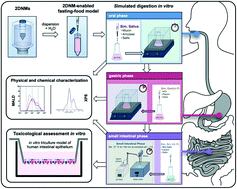Biotransformations and cytotoxicity of graphene and inorganic two-dimensional nanomaterials using simulated digestions coupled with a triculture in vitro model of the human gastrointestinal epithelium†
Abstract
Background: engineered nanomaterials (ENMs) have already made their way into myriad applications and products across multiple industries. However, the potential health risks of exposure to ENMs remain poorly understood. This is particularly true for the emerging class of ENMs know as 2-dimensional nanomaterials (2DNMs), with a thickness of one or a few layers of atoms arranged in a planar structure. Methods: the present study assesses the biotransformations and in vitro cytotoxicity in the gastrointestinal tract of 11 2DNMs, namely graphene, graphene oxide (GO), partially reduced graphene oxide (prGO), reduced graphene oxide (rGO), hexagonal boron nitride (h-BN), molybdenum disulphide (MoS2), and tungsten disulphide (WS2). The evaluated pristine materials were either readily dispersed in water or dispersed with the use of a surfactant (Na-cholate or PF108). Materials dispersed in a fasting food model (FFM, water) were subjected to simulated 3-phase (oral, gastric, and small intestinal) digestion to replicate the biotransformations that would occur in the GIT after ingestion. A triculture model of small intestinal epithelium was used to assess the effects of the digested products (digestas) on epithelial layer integrity, cytotoxicity, viability, oxidative stress, and initiation of apoptosis. Results: physicochemical characterization of the 2DNMs in FFM dispersions and in small intestinal digestas revealed significant agglomeration by all materials during digestion, most prominently by graphene, which was likely caused by interactions with digestive proteins. Also, MoS2 had dissolved by ∼75% by the end of simulated digestion. Other than a low but statistically significant increase in cytotoxicity observed with all inorganic materials and graphene dispersed in PF108, no adverse effects were observed in the exposed tricultures. Conclusions: our results suggest that occasional ingestion of small quantities of 2DNMs may not be highly cytotoxic in a physiologically relevant in vitro model of the intestinal epithelium. Still, their inflammatory or genotoxic potential after short- or long-term ingestion remains unclear and needs to be studied in future in vitro and in vivo studies. These would include studies of effects on co-ingested nutrient digestion and absorption, which have been documented for numerous ingested ENMs, as well as effects on the gut microbiome, which can have important health implications.

- This article is part of the themed collections: Nano-bio interactions and Environmental Science: Nano Recent HOT Articles


 Please wait while we load your content...
Please wait while we load your content...
